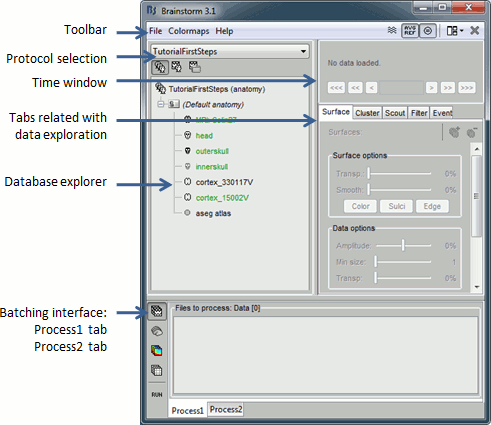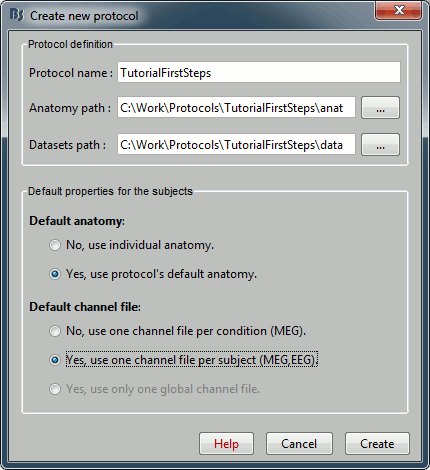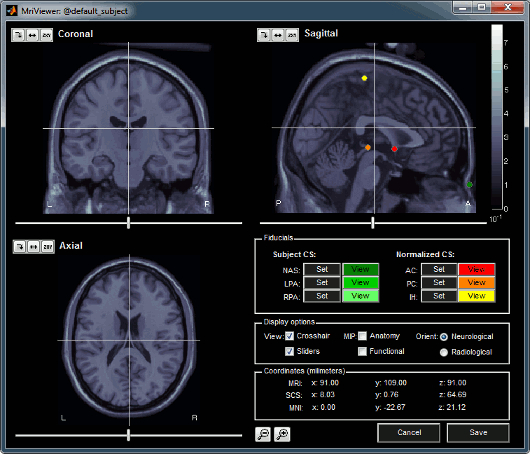|
Size: 4535
Comment:
|
Size: 5549
Comment:
|
| Deletions are marked like this. | Additions are marked like this. |
| Line 1: | Line 1: |
| ## page was renamed from Tutorials/TutFirstStart | |
| Line 2: | Line 3: |
| Objectives: Create a protocol with one subject, that uses the default anatomy Colin27. |
|
| Line 15: | Line 18: |
| == Brainstorm database == Brainstorm toolbox allows you to classify your recordings and analysis with three different levels of definition: * '''Protocol''' * Some people would prefer to call this ''experiment ''or ''study''. * It can designate all the data that were acquired on one or several subjects, with the same objectives (study of a specific cognitive task, epileptic spikes localization, functional differences between two populations). * Each protocol may include one or several subjects. * Default data can be defined at the protocol level. If you cannot get the individual MR images of all or some of your subjects, you can use a default anatomy. If you want to localize the sources for an EEG recording but do not know the location of each electrode in space, you can use standardized electrodes positions. * '''Subject''' * A person who participated in a given protocol. * You need two categories of information to define a subject: * Files describing the subject's anatomy : MRI and surfaces * Functional data files, ie. files that have a temporal dimension or that are related to a precise recording session: EEG / MEG recordings, definition of the sensors, source estimations, statistical results... * '''Condition''' * For each subject, functional files can be classified in different ''experimental conditions''. * This level of definition is also used to separate different ''runs ''(ie. recording sessions) for the same subject. Some Brainstorm database properties: * It is created and managed completely from the Brainstorm GUI (tree in the main interface window) * It is based on the files/directories architecture: * Anatomy data in: protocol_name/subject_name/'''anat'''/ * Functional data in: protocol_name/subject_name/'''data'''/condition_name/ * Each file you see in the Brainstorm window corresponds to a proper file on the hard drive; but the contrary is not necessarily true. There are extra information stored in each directory, to save properties, comments, default data, links between different items, etc. * For this reason, you should not try to manipulate directly the files in the Brainstorm database directory. * A copy of the database structure is saved by Brainstorm in your home directory, so that when you start the program or change protocol, there is no need to read again all the files on the hard drive (this may take some time).<<BR>>As a consequence, the files that are displayed in the Brainstorm window may differ from what is actually on the disk (if some process crashed, or if you moved or add some files by yourself).<<BR>>If this happens, you will have to reload the current protocol (popup menu ''Reload'') or the whole database (menu ''File > Reload database'') |
|
| Line 44: | Line 20: |
| 1. Edit the protocol name and enter: "Tutorial_FirstSteps". It will automatically update the paths to the ''Anatomy path'' and the ''Dataset path'' 1. Select the "" |
1. Edit the protocol name and enter: "!TutorialFirstSteps". It will automatically update the paths (''Anatomy path'' and ''Datasets path''. 1. Select the "''MNI Colin27''" as the default anatomy. * This anatomy (MRI & surfaces) will be available if needed by all the subjects in the protocol. * This can be changed later, using the "''Use default''" menu in the subjects' popup menu. 1. ''Subjects configuration'' panel: * These are the default settings that will be applied when creating new subjects. It is then possible to override those settings for each subject. * Our objective is to create one subject that uses the default anatomy Colin27, so select the option "''Yes, use protocol's default anatomy''". * The option selected for ''Default channel file'' is not important because we are not going to import recordings (and channel files, ie. files that describe each sensor: position, orientation, name...) 1. Once you get something like the following figure, click on ''Create''.<<BR>> {{attachment:createNewProtocol.gif}} 1. Confirm that you want to create the directories 1. The ''MRI Viewer'' window opens automatically and displays the Colin27 brain, and a message box informs you that you should select some points on the MRI. Those fiducial points are used to register the MRI with the MEG or EEG sensors, when you import recordings. We don't need to define them now, because we are not going to import any recordings in this turorial, but let's play with the MRI Viewer Viewer. <<BR>> {{attachment:mriViewer.gif}} * You can navigate through the volume by clicking anywhere in the slices, or by using the sliders below each image. 1. * There are four small buttons above each image. They may be useful when you import your own MR volumes, if they are not oriented in the way Brainstorm want them (e.g. you see the ''Sagittal ''title on top of the coronal view; or the small white "''P''", which is supposed to indicate the posterior part of the head, points the nose). Leave your mouse a few seconds over button one to read their description tooltip. Click on them and try to understand what they are doing. * Images' contrast can be changed with the mouse: click and hold the right button on one image, and move your mouse up and down (this operation will be later referred as ''right-click+move''). * You can define six points on the MRI: * * Three to define the [[CoordinateSystems|Subject Coordinate System (SCS)]]: Nasion (NAS), Left pre-auricular point (LPA), Right pre-auricular point (RPA), * Three to define the[[CoordinateSystems|Talairach coordinate system]] (referred here as ''Normalized CS''): Anterior commissure (AC), Posterior commissure (PC), and any Interhemispheric point (IH). * => To know more about [[CoordinateSystems|how to define the fiducial points]]. * To define a point, position the three views a the point your want to define (pointed by the 3 crosses), and click on the ''Set ''button. Later you can click on ''View ''to move the views to this point again. * You can see that all the points are already defined on this MRI, but you should '''always '''check their positions. For many reasons, each research group has a different way to define those points. So you may not position the ears or the nasion exactly the same way as we do. So do not hesitate to move the fiducials to better fit your needings; if not the results might be much less accurate. * The coordinates panel shows the (x,y,z) coordinates in all the coordinate systems managed by Brainstorm: MRI, SCS, and Talairach. * Once you're done, click on ''Cancel ''(unless you really want to save all your experimentations). 1. The protocol is created and you can now see it in the database explorer, in Brainstorm window. |
Tutorials: First steps
Objectives: Create a protocol with one subject, that uses the default anatomy Colin27.
Contents
Running Brainstorm for the first time
- Start Matlab, go to brainstorm3 directory, and type "brainstorm3" in Matlab command window.
- With some Matlab installations, you may observe an error message in the command window, about the compilation of the MEX files. Some files from the permutation tests functions need to be compiled on your own operating system, and you may not be able to use some statistical tests if you have such an error. You may ignore this problem, it will be fixed later.
The Licence Agreement will be display. Read the licence file, and click on "Agree" if you agree with it.
If you have two screens on your computer, you may have a message asking if you want to use your second screen. You can try to say yes: you will have the Brainstorm window on primary screen and the data figures on the secondary one). If does not work properly, go to the menu Options > GUI, and uncheck the menu "Use two screens when available".
Then you will be asked to specify Brainstorm database directory. Read carefully the Important notes and then create or select an empty directory to store your Brainstorm database (for instance "brainstorm_database", or "brainstorm_protocols").
- After a last message asking you to create or load a protocol, you should see the main Brainstorm window
Main interface window

Create first protocol
Click on the Protocol selection drop list, and select Create new protocol.
Edit the protocol name and enter: "TutorialFirstSteps". It will automatically update the paths (Anatomy path and Datasets path.
Select the "MNI Colin27" as the default anatomy.
This anatomy (MRI & surfaces) will be available if needed by all the subjects in the protocol.
This can be changed later, using the "Use default" menu in the subjects' popup menu.
Subjects configuration panel:
- These are the default settings that will be applied when creating new subjects. It is then possible to override those settings for each subject.
Our objective is to create one subject that uses the default anatomy Colin27, so select the option "Yes, use protocol's default anatomy".
The option selected for Default channel file is not important because we are not going to import recordings (and channel files, ie. files that describe each sensor: position, orientation, name...)
Once you get something like the following figure, click on Create.

- Confirm that you want to create the directories
The MRI Viewer window opens automatically and displays the Colin27 brain, and a message box informs you that you should select some points on the MRI. Those fiducial points are used to register the MRI with the MEG or EEG sensors, when you import recordings. We don't need to define them now, because we are not going to import any recordings in this turorial, but let's play with the MRI Viewer Viewer.

- You can navigate through the volume by clicking anywhere in the slices, or by using the sliders below each image.
* There are four small buttons above each image. They may be useful when you import your own MR volumes, if they are not oriented in the way Brainstorm want them (e.g. you see the Sagittal title on top of the coronal view; or the small white "P", which is supposed to indicate the posterior part of the head, points the nose). Leave your mouse a few seconds over button one to read their description tooltip. Click on them and try to understand what they are doing.
Images' contrast can be changed with the mouse: click and hold the right button on one image, and move your mouse up and down (this operation will be later referred as right-click+move).
- You can define six points on the MRI:
* Three to define the Subject Coordinate System (SCS): Nasion (NAS), Left pre-auricular point (LPA), Right pre-auricular point (RPA),
Three to define theTalairach coordinate system (referred here as Normalized CS): Anterior commissure (AC), Posterior commissure (PC), and any Interhemispheric point (IH).
=> To know more about how to define the fiducial points.
To define a point, position the three views a the point your want to define (pointed by the 3 crosses), and click on the Set button. Later you can click on View to move the views to this point again.
You can see that all the points are already defined on this MRI, but you should always check their positions. For many reasons, each research group has a different way to define those points. So you may not position the ears or the nasion exactly the same way as we do. So do not hesitate to move the fiducials to better fit your needings; if not the results might be much less accurate.
- The coordinates panel shows the (x,y,z) coordinates in all the coordinate systems managed by Brainstorm: MRI, SCS, and Talairach.
Once you're done, click on Cancel (unless you really want to save all your experimentations).
- The protocol is created and you can now see it in the database explorer, in Brainstorm window.
